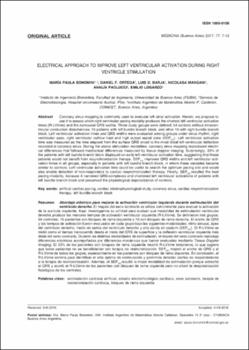| dc.contributor.author | Beroni, Maria. | |
| dc.contributor.author | Ortega, Daniel. | |
| dc.contributor.author | Barja, Luis. | |
| dc.contributor.author | Mangani, Nicolasa. | |
| dc.contributor.author | Paolucci, Analía. | |
| dc.contributor.author | Logarzo, Emilio. | |
| dc.date.accessioned | 2020-02-17T19:24:43Z | |
| dc.date.available | 2020-02-17T19:24:43Z | |
| dc.date.issued | 2017-01-01 | |
| dc.identifier.citation | Medicina (B Aires). 2017;77(1):7-12. | en_US |
| dc.identifier.issn | 0025-7680 | |
| dc.identifier.uri | https://riu.austral.edu.ar/handle/123456789/805 | |
| dc.description.abstract | Coronary sinus mapping is commonly used to evaluate left atrial activation. Herein, we propose to use it to assess which right ventricular pacing modality produces the shortest left ventricular activation times (R-LVtime) and the narrowest QRS widths. Three study groups were defined: 54 controls without intraventricular conduction disturbances; 15 patients with left bundle branch block, and other 15 with right bundle branch block. Left ventricular activation times and QRS widths were evaluated among groups under sinus rhythm, right ventricular apex, right ventricular outflow tract and high output septal zone (SEPHO). Left ventricular activation time was measured as the time elapsed from the surface QRS onset to the most distal left ventricular deflection recorded at coronary sinus. During the above stimulation modalities, coronary sinus mapping reproduced electrical differences that followed mechanical differences measured by tissue doppler imaging. Surprisingly, 33% of the patients with left bundle branch block displayed an early left ventricular activation time, suggesting that these patients would not benefit from resynchronization therapy. SEPHO improved QRS widths and left ventricular activation times in all groups, especially in patients with left bundle branch block, in whom these variables became similar to controls. Left ventricular activation time could be useful to search the optimum pacing site and would also enable detection of non-responders to cardiac resynchronization therapy. Finally, SEPHO resulted the best pacing modality, because it narrowed QRS-complexes and shortened left ventricular activations of patients with left bundle branch block and preserved the physiological depolarization of controls. | en_US |
| dc.language.iso | en | en_US |
| dc.publisher | Fundación Revista Medicina | en_US |
| dc.subject | Artificial cardiac pacing | en_US |
| dc.subject | Cardiac electrophysiological study | en_US |
| dc.subject | Cardiac resynchronization therapy | en_US |
| dc.subject | Coronary sinus | en_US |
| dc.title | Electrical approach to improve left ventricular activation during right ventricle stimulation. | en_US |
| dc.type | Article | en_US |


